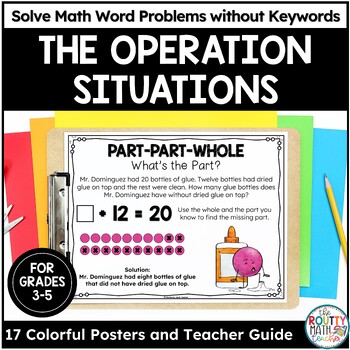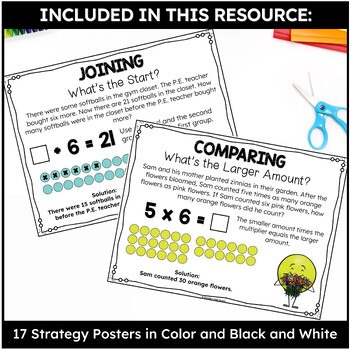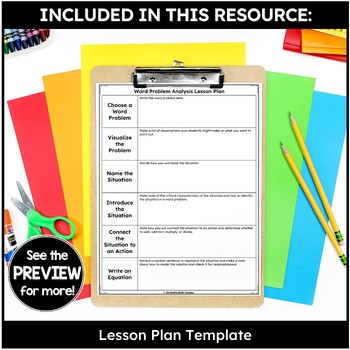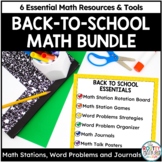Operation Situations for Word Problems: Math Strategy Posters and Anchor Charts
- PDF
What educators are saying
Also included in
- Are you looking for a reliable math problem solving structure and practice solving math word problems?This bundle of resources is designed to: Help students understand and analyze math word problems without using keywordsTeach students to see the “big picture,” determine the overall action(s) takinPrice $9.60Original Price $12.00Save $2.40
- Are you looking for all the things you need to get your math classroom ready for back to school? This bundle includes back-to-school math essentials for every classroom including math bulletin boards, a math station rotation board, math board game templates, strategies for solving math word problemsPrice $18.83Original Price $26.90Save $8.07
Description
Tired of your students relying on math key words to solve math word problems?
Empower your students to master analyzing math word problems – without using operation key words! This resource is designed for teachers who want to teach their students math strategies to help them analyze addition, subtraction, multiplication, and division word problems without using word problem keywords. With the operation situations in their mental toolkits, your students will never use keywords again!
What’s included?
✅ 17 Colorful Posters
✅ Printer-friendly Poster Set
✅ Teaching Strategies
✅ Sample Lesson Plan
✅ Blank Lesson Plan Template
✅ Quarter-size Student Poster Set
✅ Anchor Chart Template
➡️ Check out the preview to learn more about this resource!
What’s unique about this product?
❤️ No more keywords! This resource teaches students how to analyze addition, subtraction, multiplication, and division word problems through visualization.
❤️ This resource includes 17 engaging visuals that emphasize everyday situations students encounter when solving math word problems. From joining and separation to part-part-whole and comparing scenarios, we've got them covered!
❤️ The detailed teacher guide includes teaching strategies, troubleshooting tips, and a sample lesson plan teachers can use to introduce the operation situations.
❤️ This resource includes a set of quarter-size posters that can be glued into student notebooks or other help tools so students can refer to them when solving math word problems independently.
Teachers Like You Said . . .
⭐️⭐️⭐️⭐️⭐️Thank you so much for this brilliant resource. My student has been struggling with choosing the operation in 1 step word problems and the visual charts and scenarios I came up with only further confused her. Your resource saved me hours, endless hours, of figuring out various visual models. You must be a brilliant math teacher. ~ Aura F., 3rd Grade Teacher
⭐️⭐️⭐️⭐️⭐️ This strategy for teaching students to solve word problems is a game changer. I have always relied on the "clue words", but this makes so much more sense. Students are able to understand the problem and aren't just relying on taking the clue word shortcut. ~ Elizabeth L., 3rd Grade Teacher
⭐️⭐️⭐️⭐️⭐️ This was a great visual. After explaining and practicing with the concepts, the students put a copy in their notebooks and even independently referred to it later. Thank you! ~ Rachel V., 6th Grade Teacher
I hope this resource helps your students master math word problems!- The Routty Math Teacher
----------------------------------------------------------
Keep up with The Routty Math Teacher!
Be the first to learn about doing math The Routty Way. I will send information about new blog posts, free resources, and new product information. Sound interesting? Become a follower of The Routty Math Teacher by clicking here or on the green star on any of my product pages and receive email updates in your TPT inbox.
Be the first to learn about doing math The Routty Way. I will send information about new blog posts, free resources, and new product information. Sound interesting? Become a follower of The Routty Math Teacher by clicking here or on the green star on any of my product pages and receive email updates in your TPT inbox.
Leave feedback and receive TPT credit!
Did you know you can build TPT credits by leaving feedback on our products?
You can submit feedback at the time of purchase or go to “My Purchases” for a list of what you have bought in the past. Next to each title is a “Leave Feedback” button. Click it and leave a rating and comment to receive the credit. Go to TPT Credits to learn how to redeem your credits on future purchases!
Like this pack? Share it with others!
Use the share buttons so others will find it! Just click the Facebook, Twitter, or Pinterest button to share it with others!
Terms of Use: This product is copyrighted by Shametria Routt Banks. All rights reserved. Purchase of this product entitles the purchaser the right to reproduce the pages in limited quantities for classroom use only. Duplication for an entire school, an entire school system, or commercial purpose is strictly forbidden without written consent from the publisher. For questions, please contact Shametria@therouttymathteacher.com







